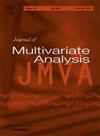Markov switching multiple-equation tensor regressions
IF 1.4
3区 数学
Q2 STATISTICS & PROBABILITY
引用次数: 0
Abstract
A new flexible tensor model for multiple-equation regressions that accounts for latent regime changes is proposed. The model allows for dynamic coefficients and multi-dimensional covariates that vary across equations. The coefficients are driven by a common hidden Markov process that addresses structural breaks to enhance the model flexibility and preserve parsimony. A new soft PARAFAC hierarchical prior is introduced to achieve dimensionality reduction while preserving the structural information of the covariate tensor. The proposed prior includes a new multi-way shrinking effect to address over-parametrization issues while preserving interpretability and model tractability. Theoretical results are derived to help with the choice of the hyperparameters. An efficient Markov chain Monte Carlo (MCMC) algorithm based on random scan Gibbs and back-fitting strategy is designed with priority placed on computational scalability of the posterior sampling. The validity of the MCMC algorithm is demonstrated theoretically, and its computational efficiency is studied using numerical experiments in different parameter settings. The effectiveness of the model framework is illustrated using two original real data analyses. The proposed model exhibits superior performance compared to the current benchmark, Lasso regression.
马尔可夫切换多方程张量回归
提出了一种新的考虑潜在状态变化的多方程回归柔性张量模型。该模型允许动态系数和多维协变量在不同的方程中变化。系数由一个常见的隐马尔可夫过程驱动,该过程解决了结构断裂,以增强模型的灵活性并保持简约性。在保留协变量张量的结构信息的同时,引入了一种新的软PARAFAC层次先验来实现降维。提出的先验包括一个新的多路收缩效应,以解决过度参数化问题,同时保持可解释性和模型可追溯性。理论结果的推导有助于超参数的选择。设计了一种基于随机扫描Gibbs和反拟合策略的高效马尔可夫链蒙特卡罗(MCMC)算法,优先考虑后验抽样的计算可扩展性。从理论上论证了MCMC算法的有效性,并通过数值实验研究了不同参数设置下MCMC算法的计算效率。通过两个原始的实际数据分析,说明了模型框架的有效性。与当前的基准Lasso回归相比,所提出的模型表现出优越的性能。
本文章由计算机程序翻译,如有差异,请以英文原文为准。
求助全文
约1分钟内获得全文
求助全文
来源期刊

Journal of Multivariate Analysis
数学-统计学与概率论
CiteScore
2.40
自引率
25.00%
发文量
108
审稿时长
74 days
期刊介绍:
Founded in 1971, the Journal of Multivariate Analysis (JMVA) is the central venue for the publication of new, relevant methodology and particularly innovative applications pertaining to the analysis and interpretation of multidimensional data.
The journal welcomes contributions to all aspects of multivariate data analysis and modeling, including cluster analysis, discriminant analysis, factor analysis, and multidimensional continuous or discrete distribution theory. Topics of current interest include, but are not limited to, inferential aspects of
Copula modeling
Functional data analysis
Graphical modeling
High-dimensional data analysis
Image analysis
Multivariate extreme-value theory
Sparse modeling
Spatial statistics.
 求助内容:
求助内容: 应助结果提醒方式:
应助结果提醒方式:


